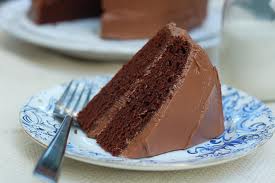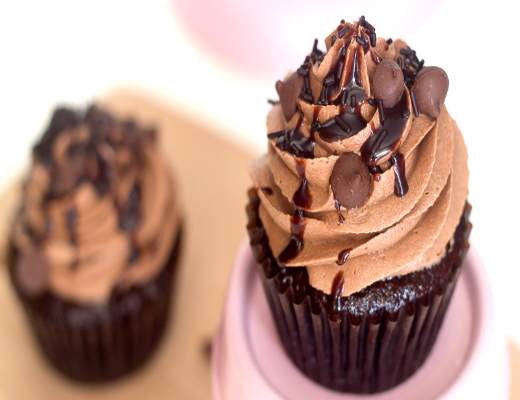 I have never believed, as some people do, that you either have a gift for baking cakes or you dont. Have you ever looked at a piece of cake thinking its going to be moist only to find that its really dry? If you love to bake cakes (or cupcakes) but find they are not as moist as they should be then read on. Whether from scratch or a box mix, with a little practice and a few tips you can make moist and delicious cakes.
I have never believed, as some people do, that you either have a gift for baking cakes or you dont. Have you ever looked at a piece of cake thinking its going to be moist only to find that its really dry? If you love to bake cakes (or cupcakes) but find they are not as moist as they should be then read on. Whether from scratch or a box mix, with a little practice and a few tips you can make moist and delicious cakes.
First, here is a quick lesson on the science behind making cakes:
Ingredients for cakes (whether from scratch or a mix) include the same things. Most cakes are composed of flour, sugar, eggs, and a fat for moistness (either oil or butter). In fact, classic pound cake requires nothing more than these basic ingredients: one pound each of flour, sugar, eggs, and butter. The trick when it comes to baking is not to upset this balance of ingredients too much. When baking from scratch, you must first see that the basic chemical balance is in order. If you want to change the cake then you must find a way to do so without upsetting this balance. This assumes the balance is right to begin with.
Alterations can be made, but they still must allow the basic ingredients to do their magic and produce a basic cake. If you want the cake to taste a little richer than a basic cake, add extra fats. If you want a denser cake, reduce the amount of eggs. And, if you want the cake to be more bread-like then add a bit more flour. There’s a variation for almost every taste.
Here is some science that you dont see:
When fat and sugar are mixed together the process in a recipe is called creaming little bubbles of air are being trapped in the mixture, each one is surrounded by a film of fat (which is why the mixture changes color during creaming as the trapped air creates a foam-like look). It is this air which produces the lightness in the finished cake, but unless eggs are added to the mixture the fat would collapse and the air escape during cooking. The egg forms a layer around each air bubble, and as the temperature of the cake increases then this layer coagulates and forms a rigid wall round each bubble, preventing it from bursting and ruining the texture of the cake.
While it is baking, the bubbles of air will expand and the cake will rise. At the same time the stretchy gluten in the flour which has formed an elastic network round the air bubbles will stretch until it loses its elasticity and the shape of the cake becomes fixed. But until that moment of expansion is reached, the baking must occur uninterrupted. This is why 1) the cake should be baked as soon as the batter is mixed and 2) the oven door should never be opened in the early stages of cooking. If the door is opened the temperature will drop suddenly and the air in the cake will stop expanding and actually contract. The whole structure of the cake will then sink back because theres nothing to prop it up. So, remember, never look at a cake until three-quarters of the cooking time has elapsed.
My tips for making a moist cake:
Here are a few tips that I use for making moist cakes:
The most important thing is to not overcook the cake or cupcakes. Bake according to the recipe but check for doneness the last 5-10 minutes before scheduled. You know its done when a toothpick in the center comes out with just a few cake crumbs attached or the cake springs back when pressed in the center. You can also pull the crumbs off the toothpick and rub them between your fingers to see if they are too moist or just right. I believe the cake will taste better if it is slightly undercooked than slightly overcooked. I found that cake (or cupcakes) will continue to cook just a little bit more after you take it out of the oven so if you test it and it needs just a couple more minutes, take it out and set it on the stove. My rule of thumb for cupcakes is 28 minutes on 325. They come out great every time. Since all ovens vary, find out what works for your oven and then modify recipes accordingly.
I use sour cream in most of my recipes for moistness. You can also add mayonnaise or applesauce to increase moistness. Be careful though, dumping in gobs of moistening agents often leads to little more than a soggy, wet mess. Dont confuse “moist” with “wet.” If you are making a box mix then I would say add 1 cup of sour cream for each box of cake mix. This is in addition to the recipe ingredients, not as a substitute.
Egg whites can dry out a cake, so baking experts recommend using just the egg yolks for a moister cake. I have never tried just the egg yolks but have added an extra egg. This explains why white cakes are usually drier than other flavors . . . there are no egg yolks in white cakes.
Make cupcakes the day before you need them. Frost and decorate them and then put them in an air tight container. Unless you use a frosting that has to be refrigerated (like cream cheese), leave them at room temperature. Im not sure exactly why but letting them sit one day will make them very moist and richer tasting. If you use buttercream frosting (that does not have to be refrigerated) then you can even make them two days prior to when you need them. Cupcakes can be good for about 5-7 days. I cant be exact because Ive never made any that lasted that long.
For cakes, make them a couple days in advance. Heres a trick that works wonders . . . immediately after you take the cake out of the oven, wrap it in plastic wrap and put it in the freezer. I put about two to three layers of plastic wrap on it. The heat from the cake will make the plastic wrap mold nicely against the cake. Take the cake out of the freezer the day you plan to frost it. Depending on the size, it will only take a couple hours to thaw out. As its thawing, the condensation that was created during the wrapping phase is now being soaked back into the cake, making it very moist!
Brush cake layers with simple syrup made by simmering equal amounts of water and sugar in a saucepan until the sugar dissolves completely. The syrup keeps the layers moist.
Other tips for making a moist cake:
Here are some other tips I have heard but have never tried:
Try adding an extra quarter-cup of sugar to the recipe, a little extra butter, or a touch more oil (oil can slow down gluten production during the baking process, which can dry out a cake).
Brown sugar holds more moisture longer than white sugar. Replacing brown sugar for white sugar will keep the cake from drying out and maintain its moistness. Use the same measurements for the brown sugar as your recipe called for the white sugar. The taste difference will be minimal, but the moisture levels will be higher.
Mix you batter as you normally would then add one small container of yogurt to the mix and bake as usual. This will keep the cake moist for days.
Use only egg yolks instead of the whole egg (use 3 yolks instead of 2 eggs, for example). This works for cookies, too.
Don’t stir the mix too much! This develops the gluten in the flour and makes it chewy. The batter should look a little under-stirred when you pour it in the pan.
Use baking powder instead of baking soda. The bicarbonate by itself neutralizes the acid in the batter and makes it darken more. Baking powder won’t reduce the acidity, making the cake fluffier.
Use a stoneware pan if you’re really serious about it; the temperature stays more even in the pan, so that the center and edges are done at the same time.
Add one box of pudding to the mix.
There are several ways on the internet to making a great cake. Try one every time you make a cake or cupcakes and see what works for you. Now its time to test your new baking skills!
Happy Baking!
Donna

